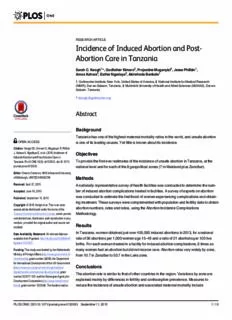
Incidence of Induced Abortion and Post-Abortion Care in Tanzania PDF
Preview Incidence of Induced Abortion and Post-Abortion Care in Tanzania
RESEARCHARTICLE Incidence of Induced Abortion and Post- Abortion Care in Tanzania SarahC.Keogh1*,GodfatherKimaro2,ProjestineMuganyizi3,JessePhilbin1, AmosKahwa2,EstherNgadaya2,AkinrinolaBankole1 1 GuttmacherInstitute,NewYork,UnitedStatesofAmerica,2 NationalInstituteforMedicalResearch (NIMR),Dar-es-Salaam,Tanzania,3 MuhimbiliUniversityofHealthandAlliedSciences(MUHAS),Dar-es- Salaam,Tanzania *[email protected] Abstract Background Tanzaniahasoneofthehighestmaternalmortalityratiosintheworld,andunsafeabortion OPENACCESS isoneofitsleadingcauses.Yetlittleisknownaboutitsincidence. Citation:KeoghSC,KimaroG,MuganyiziP,Philbin J,KahwaA,NgadayaE,etal.(2015)Incidenceof Objectives InducedAbortionandPost-AbortionCarein Tanzania.PLoSONE10(9):e0133933.doi:10.1371/ ToprovidethefirsteverestimatesoftheincidenceofunsafeabortioninTanzania,atthe journal.pone.0133933 nationallevelandforeachofthe8geopoliticalzones(7inMainlandplusZanzibar). Editor:SharonCameron,NHSlothianandUniversity ofEdinburgh,UNITEDKINGDOM Methods Received:April27,2015 Anationallyrepresentativesurveyofhealthfacilitieswasconductedtodeterminethenum- Accepted:June16,2015 berofinducedabortioncomplicationstreatedinfacilities.Asurveyofexpertsonabortion wasconductedtoestimatethelikelihoodofwomenexperiencingcomplicationsandobtain- Published:September11,2015 ingtreatment.Thesesurveyswerecomplementedwithpopulationandfertilitydatatoobtain Copyright:©2015Keoghetal.Thisisanopen abortionnumbers,ratesandratios,usingtheAbortionIncidenceComplications accessarticledistributedunderthetermsofthe CreativeCommonsAttributionLicense,whichpermits Methodology. unrestricteduse,distribution,andreproductioninany medium,providedtheoriginalauthorandsourceare Results credited. InTanzania,womenobtainedjustover405,000inducedabortionsin2013,foranational DataAvailabilityStatement:Allrelevantdataare availablefromFigshare:http://dx.doi.org/10.6084/m9. rateof36abortionsper1,000womenage15–49andaratioof21abortionsper100live figshare.1521553. births.Foreachwomantreatedinafacilityforinducedabortioncomplications,6timesas Funding:ThisstudywasfundedbytheNetherlands manywomenhadanabortionbutdidnotreceivecare.Abortionratesvarywidelybyzone, MinistryofForeignAffairs(http://www.government.nl/ from10.7inZanzibarto50.7intheLakezone. ministries/bz),grantnumber24590;theDepartment forInternationalDevelopmentoftheUKGovernment Conclusions (https://www.gov.uk/government/organisations/ department-for-international-development),grant Theabortionrateissimilartothatofothercountriesintheregion.Variationsbyzoneare number203177-101;andtheNorwegianAgencyfor explainedmainlybydifferencesinfertilityandcontraceptiveprevalence.Measuresto DevelopmentCooperation(http://www.norad.no/en/ front/),grantnumber1300340.Thefundershadno reducetheincidenceofunsafeabortionandassociatedmaternalmortalityinclude PLOSONE|DOI:10.1371/journal.pone.0133933 September11,2015 1/13 AbortionIncidenceinTanzania roleinstudydesign,datacollectionandanalysis, expandingaccesstopost-abortioncareandcontraceptiveservicestopreventunintended decisiontopublish,orpreparationofthemanuscript. pregnancies. CompetingInterests:Theauthorshavedeclared thatnocompetinginterestsexist. Introduction Withthe2015MillenniumDevelopmentGoals(MDG)deadlineuponus,countriesareevalu- atingtheirprogressinreachingtheirtargets.Despiteachievinga55%reductionbetween1990 and2015,TanzaniaisfallingshortofitsMDG5targetofcuttingmaternalmortalitybythree quarters,andcontinuestohaveoneofthehighestmaternalmortalityratiosintheworld,at 410per100,000livebirths[1].Innationalconsultationsonthepost-2015developmentagenda, reducingmaternalmortalitywasupheldasoneofthetenkeygoals.Yetthiscannotbeachieved withoutaddressingoneofitsleadingcauses,unsafeabortion. Globally,unsafeabortionsaccountforbetween8%and18%ofmaternaldeaths[2,3],and millionsmorewomensuffernonfatalhealthconsequencesofunsafeabortioneveryyear[4].In EastAfricaalone,anestimated613,000womenwerehospitalizedforcomplicationsfrom inducedabortionin2005,or10per1,000womenofreproductiveage.Manymorewomensuf- fercomplicationsbutdonotaccesscare:worldwide,anestimatedonethirdofthe8.5million womenwithabortioncomplicationsarenottreatedinfacilities[4].Globalandregionalesti- matesofabortionincidenceindicatethatabortionsarenolesscommon,andmuchmorelikely tobeunsafe,insettingswithrestrictivelawsthaninsettingswithliberallaws[5].Moreover,in countrieswhereabortionisillegalorhighlyrestricted,statisticsareoftennotavailable,making itdifficulttoascertainthemagnitudeofunsafeabortionanditsconsequences.InTanzania,no nationallyrepresentativestudieshavebeenconductedtodeterminetheincidenceofabortion. However,accordingtoregionalestimates,in2008therewere2.4millionunsafeabortions,or 36perthousandwomenofreproductiveage,inEastAfrica[6]. ThelittleevidenceavailableforTanzania,mainlyfromsmall-scalehospital-basedstudies, pointstoinducedabortionbeingwidespread,largelyunsafe,andassociatedwithhighmorbid- ityandmortality.Accordingtothesestudies,justover60%ofwomenadmittedtohospitalfor amiscarriagehadinfacthadaninducedabortion[7–9].Unsafeabortionsaccountedfor38% ofhospitalizationsforobstetriccomplicationsinonestudy[10],androughlyaquarterof maternaldeathsintwootherhospitalstudies[11,12]. ThelegalstatusofabortionisambiguousinTanzania:thePenalCodeisbroadlyunderstood toauthorizeabortiontosaveawoman’slife,butremainsunclearonitslegalitytopreservethe woman’sphysicalormentalhealth[13].AlthoughTanzaniaratifiedthe2007AfricanCharter’s ProtocolontheRightsofWomeninAfricaallowingabortionincasesofrape,incestorifthe pregnancyendangersthewoman’slife,mentalorphysicalhealthorthelifeofthefetus[14], thegovernmenthasnotincorporatedtheseprovisionsintoitsnationallaw.Thereisalsoambi- guityoverwhetherauthorizationisneededfrommorethanoneproviderbeforeperformingan abortion[13,15].Thislackofclaritycreatesconfusionamongsthealthcareprovidersand womenalike,andfearofprosecutiononbothsidespusheswomentoseekclandestineabor- tionsthatareoftenunsafe.Asfewpeoplearewillingtotalkaboutabortion,verylittleinforma- tionisavailableonthescopeoftheproblem.Thisperpetuatestheinvisibilityofunsafe abortion,resultinginthegovernmentgivingitlittlepriorityinpolicydecisions,servicedelivery orprogramimplementation. Inrecentyears,theTanzaniangovernmenthasshownstrongcommitmenttoreducing maternalmortalityandmorbiditythroughinitiativessuchastheNationalRoadMapStrategic PlantoAccelerateReductionofMaternal,NewbornandChildDeaths[16],andtheapproval ofMisoprostolfirstforpostpartumhemorrhagein2007andthenfortreatmentofincomplete PLOSONE|DOI:10.1371/journal.pone.0133933 September11,2015 2/13 AbortionIncidenceinTanzania abortionin2011[17].Buildingonacomprehensivepost-abortioncare(PAC)trainingpro- gramlaunchedin2000,theTanzanianMinistryofHealthandSocialWelfarehassince2007 beenexpandingPACservicestolowerlevelfacilitiesinanefforttoincreasetheiravailability throughoutthecountry.However,stillmoreneedstobedonetoensureuniversalaccessto PAC.Manylowerandmid-levelfacilitiesstilllackequipmentsuchasmanualvacuumaspira- tionkits[18,19],andmanyhospitaldeathsfollowinganabortioncouldbeavoidedwithade- quatetrainingandstaffing[12].EffortstoexpandaccesstocomprehensivePACrequiremore evidenceonthescaleofinducedabortioninTanzania,bothatthenationalandsub-national level,todeterminewhereinvestmentsaremostneededandhowtoallocateresources. Reducingunsafeabortionalsoimpliestacklingitsrootcause,unintendedpregnancy.The wantedtotalfertilityrate(TFR),at4.7childrenperwoman,remainssignificantlylowerthan theactualTFRof5.4,dueinparttolowcontraceptiveuse(25%amongstmarriedwomen) [20].In2010,26%ofbirthswereunplanned,representingaslightincreasesince2005.Estimat- ingthemagnitudeofunintendedpregnancy,crucialforinformingreproductivehealthpro- gramsandcontraceptiveservicedelivery,requiresdataonabortionincidence. Thispaperpresentsfindingsfromthefirst-evernationallyrepresentativestudymeasuring theincidenceofabortioninTanzania.Thisstudyrespondstotheexpressneedsofin-country andinternationaladvocatesworkingtopromotereproductivehealthinTanzania,whohave highlightedthedearthofevidenceonabortionasamajorbarriertoinformeddebateonthe issue.Thispaperprovidesnationalandzonalestimatesoftheincidenceofinducedabortion, abortioncomplicationsandunintendedpregnancy,withaviewtoinformingstrategiesto reducethecountry’shighmaternalmortality. MaterialsandMethods Incountrieswhereabortionislegallyrestrictedandstigmatized,theapproachtoestimating abortionincidencemustoftenbeindirect.Toovercomelimitationsintheavailabilityofofficial statistics,theGuttmacherInstitutehasdevelopedtheAbortionIncidenceComplicationsMeth- odology(AICM)[21]toestimateabortionincidenceinthesesettings.TheAICMhasbeen appliedinabout25countriesworldwide,includingSenegal[22],Ethiopia[23],BurkinaFaso [24],Uganda[25],Rwanda[26],Kenya[27],andMalawi[28]insub-SaharanAfrica.Themeth- odologyinvolvesestimatingthenumberofinducedabortioncomplicationstreatedinfacilities, andusingexpertopinionstoestimate,foreachcomplicationthatreachesafacility,howmany inducedabortionsareoccurringwithoutcomplicationsorwithuntreatedcomplications. Theprimarydataforthisstudycomefromtwosurveysconductedbytheauthors:aHealth FacilitiesSurvey(HFS)tomeasurethenumberofabortioncomplicationstreatedinhealth facilities,andaHealthProfessionalsSurvey(HPS)toestimatethelikelihoodofwomen experiencingabortioncomplicationsandofobtainingtreatmentatahealthfacility.Thestudy designandprotocolsareadaptedfrompreviousapplicationsofthemethodology,toberelevant totheTanzaniancontext.DatacollectionwasledbytheTanzanianNationalInstituteforMed- icalResearch(NIMR)inDar-es-Salaam,withtechnicalsupportfromMuhimbiliUniversityof HealthandAlliedSciences(MUHAS)andtheGuttmacherInstitute.Thedatafromthetwo surveyswereusedtogetherwithestimatesofbirths,unintendedbirths,andwomenofrepro- ductiveage,compiledfromthe2010TanzaniaDemographicandHealthSurvey[20]andthe 2012Tanzaniannationalcensus[29]andprojectedto2013usingTanzania'sintercensalannual growthrate.Estimateswereobtainedatthenationallevel,aswellasforeachofthe8geopoliti- calzonesofTanzania(7inmainland,plusthesemi-autonomousZanzibararchipelago). FieldworkwasconductedfromJulytoSeptember2013.Interviewerswererecentmedical graduateswithpreviousexperienceadministeringsurveys.FortheHFS,ateamoffour PLOSONE|DOI:10.1371/journal.pone.0133933 September11,2015 3/13 AbortionIncidenceinTanzania interviewerswasassignedtoeachzone,andmembersoftheresearchteamatNIMRactedas teamleads.TheseteamleadsalsoconductedtheHPSinterviews,astheHPSquestionnaire requiredmoreskillandexperience,andmanyrespondentswereseniorprofessionals.Allinter- viewersandteamleadsunderwentaweek-longtraininginDar-es-Salaam.Bothsurveyswere pilotedin5facilitieswhichwerenotpartofthefinalsample. HeathFacilitiesSurvey ThesamplingframeconsistedoftheMinistryofHealth’smostrecentlistofallhealthfacilities (publicandprivate)consideredlikelytoprovidepost-abortioncare(PAC).Aseparatelistofall publicandprivatefacilitieswasobtainedfromtheZanzibarMinistryofHealth.Facilitiesthat didnotprovideprimarycare,thatwerespecializedinnon-reproductiveservices,orthatother- wiselackedthecapacitytoprovidePAC(asforsomedispensaries),wereexcludedfromthe samplingframe.Toensurethatthelistwasuptodate,alldistrictmedicalofficersinthecoun- trywerecontactedtoconfirmthatallhealthfacilitiesintheirdistrictwereincludedinthelist, andtodeterminewhichfacilitieswereequippedtoprovidePAC. ThefinalsamplingframeoffacilitieslikelytoprovidePACincluded952facilities,ofwhich 5(0.5%)wereconsultanthospitals,20(2.1%)regionalhospitals,224(23.6%)sub-regionalhos- pitals(districthospitalsorotherhospitals),526(55.2%)healthcentersand177(18.6%)dispen- saries(Table1).AlthoughtherewerethousandsofdispensariesinTanzania,only177provided orwereexpectedtoprovidePACatthetimeweconductedthestudy.Thenomenclaturefor facilitiesinZanzibarisslightlydifferent,withPrimaryHealthCareCenters(PHCCs)beingthe equivalentofhealthcenters,andPrimaryHealthCareUnits(PHCUs)beingtheequivalentof dispensaries.WithinPHCUs,someprovideonlybasicprimarycareservices(PHCU),while othersareequippedtoprovideawiderrangeofservicesincludingPAC(PHCU+).PHCCsand PHCU+werecombinedwithhealthcentersanddispensariesrespectivelyinthenationallevel analyses. Thesamplingframewasstratifiedbyfacilitylevelwithineachzone,toensurethattheesti- matesofabortionincidencewererepresentativeatboththenationalandzonallevels.Within eachzone,weselected100%ofconsultantandregionalhospitals,66%ofnon-regionalhospi- tals,45%ofhealthcenters,and44%ofdispensariesequippedtoofferPAC,resultinginatotal of487healthfacilitiesintheinitialsample.Ofthese,481agreedtoparticipateinthesurvey (Table1).Tominimizerefusals,lettersfromtheMinistryofHealthintroducingandauthoriz- ingthestudyweresenttoallfacilitiesinadvanceofthefieldwork,andfacilityin-chargeswere Table1. Characteristicsofsample,byfacilitytype,HealthFacilitiesSurvey,Tanzania2013. Numberoffacilitieslikelyproviding Number Number NumberprovidingPACbyownership PAC selected responded (sampling (response proportion) rate) Public Private Faith-based Total organization Facilitylevel Consultanthospital 5 5 (100%) 5 (100%) 3 0 2 5 Regionalhospital 20 20 (100%) 20 (100%) 18 0 2 20 Non-regional 224 149 (66%) 144 (97%) 60 23 59 142 hospital Healthcenter 526 235 (45%) 234 (100%) 181 9 18 208 Dispensary 177 78 (44%) 78 (100%) 68 2 3 73 Total 952 487 (51%) 481 (99%) 330 34 84 448 doi:10.1371/journal.pone.0133933.t001 PLOSONE|DOI:10.1371/journal.pone.0133933 September11,2015 4/13 AbortionIncidenceinTanzania contactedtoinformthemabouttheupcomingsurvey.Ofthefacilitiesthatresponded,448 (93%)actuallyprovidedPACservices.MosthealthfacilitiesinTanzaniaaregovernment- owned,andthisisreflectedinthesample:only26%ofallfacilities(mostlyhospitals)werepri- vateorfaith-based(Table1). Astructuredquestionnairewasadministeredbyaninterviewertothemostqualifiedstaff memberorthepersoninchargeofprovidingPACineachfacility,typicallythechiefofthe ObstetricsandGynecologydepartmentinlargerfacilities,andthefacilityheadinhealthcen- tersordispensaries.Respondentswereaskedwhethertheirfacilitiesprovidetreatmentfor abortioncomplications(frombothspontaneousandinducedabortion),andifso,toestimate thenumberofPACpatientstreatedasoutpatientsandinpatients,inanaveragemonthandthe pastmonth.Specifyingtwotimeframesincreasesthelikelihoodofcapturingvariationfrom monthtomonth.Thesetwonumbersweresubsequentlyaveragedandmultipliedby12topro- duceanestimateforthe2013calendaryear. HealthProfessionalsSurvey TheHealthProfessionalsSurveyinterviewedapurposivesampleof202expertsknowledgeable aboutabortionprovisioninTanzania.Thesamplewascreatedthroughconsultationwitha broadnetworkofcolleaguesengagedinresearch,policy,communityandregional-levelpublic healthprograms,whichaimedtoidentifytheindividualsmostknowledgeableabouttheprovi- sionofabortionatthenationallevel,aswellasineachzone.Theexpertscamefromawide rangeofprofessions.Forty-sixpercentwerehealthprofessionals,includingobstetricians/gyne- cologists,midwivesandnursesfromthepublicandprivatesector,aswellasasizeablepropor- tionofnon-formallytrainedhealthworkerssuchascommunityhealthworkers,traditional birthattendantsandtraditionalhealers(15%oftotalsample).Theremaining54%ofthesam- plewascomposedofresearchers,reproductivehealthadvocates,non-governmentalorganiza- tion(NGO)andwomen’sgroups’representatives,lawyers,journalistsworkingonreproductive healthissues,programmanagersandpolicymakers,communityleaders,andyouthleaders. Respondentsweredistributedequallybetweenthe8zones.Particulareffortwasmadetoensure thattherewassufficientrepresentationofexpertswithknowledgeofruralareas.About36%of respondentshadworkedatleast6monthsinruralareasduringthelast5years.All202pro- spectiverespondentsagreedtoparticipate.Questionnairessoughtinformationonthepropor- tionofwomenwhoexperienceacomplicationfromaninducedabortion,andtheproportion likelytoreceivecareinafacilityshouldtheyexperienceacomplication,separatelyforrural andurban,poorandnon-poorwomen. Ethicsstatement EthicalapprovalwasobtainedfromGuttmacher’sInstitutionalReviewBoard,theTanzanian MedicalResearchCoordinatingCommittee,andZanzibarMedicalResearchCouncil.All respondentsinbothsurveysgavewritteninformedconsentbeforebeinginterviewed. Dataanalysis FromtheHealthFacilitiesSurvey(HFS),weobtainedestimatesofthenumberofpatients treatedforabortioncomplicationsnationallyandforeachzone.Toensureestimateswererep- resentativeatthenationalandzonallevels,weightswereassignedtoeachfacilitybyleveland zone,basedontheirselectionprobabilityandonnon-responserates.Toavoiddouble-counting patientstreatedatonefacilitylevelthenreferredtoanotherforadditionaltreatment,wesub- tracted75%ofpatientstreatedthenreferredateachfacilitylevelfromthenumbertreatedat thenextlevel,basedonaninformedestimatethatroughly75%ofpatientsreferredforobstetric PLOSONE|DOI:10.1371/journal.pone.0133933 September11,2015 5/13 AbortionIncidenceinTanzania complicationsfollowupinTanzania(urbanandruralsettingscombined)[30].Duetothesim- ilaritybetweencomplicationsfrominducedandspontaneousabortions,andthepossibilityof patientsand/orprovidersmisreportinginducedabortionsasspontaneousforfearoflegalsanc- tions,itisdifficulttoobtainaccurateestimatesofcomplicationssolelyfrominducedabortions atthefacilitylevel.Thereforethesurveyrecordedthenumberofcomplicationsfromallabor- tions(bothinducedandspontaneous),fromwhichwethensubtractedthoseduetospontane- ousabortion,toobtainthenumberofinducedabortioncomplicationstreatedinhealth facilities,nationallyandbyzone[21].Thenumberofspontaneousabortioncomplications treatedinfacilitieswascalculatedusingindirectestimationtechniques.Assumingthatonly secondtrimesterspontaneousabortionsrequirecare,andthattheseequal3.41%oflivebirths basedonclinicalstudies[31,32],weobtainedthenumberofspontaneousabortionsthatwould needtreatmentnationallyandbyzone.However,notallspontaneousabortionsrequiringcare willactuallybetreatedinfacilitiesforanumberofreasons,includinglackofaccessoraprefer- encetoseektreatmentfromuntrainedproviders.Toestimatetheproportionofspontaneous abortionsneedingcarethatwereactuallytreatedinhealthfacilitiesineachzone,weassume thatthisproportionissimilartotheproportionofrecentbirthsthatwereeitherdeliveredin healthfacilitiesornotdeliveredinhealthfacilitiesbecauseitwasnotcustomaryornecessary. The2010DHSestimatewasprojectedto2013basedonpercentchangebetweenthelasttwo DHSrounds)andadjustedittoincludewomenwhowouldhavedeliveredinhealthfacilities haditbeencustomaryornecessaryusingDHSinformationonwomen’sreasonsfornotdeliv- eringatfacilities. Butnotallinducedabortionswillresultintreatedcomplications.Somewillbedonewithout complications,whileotherswillendincomplicationsthatarenottreatedinhealthfacilitiesfor variousreasons,includinglackofaccess,fearofprosecution,preferencetoseektreatmentfrom untrainedprovidersorevendeath.TheHPSprovidedestimatesoftheprobabilityofexperienc- inginducedabortioncomplicationsbytypeofabortionprovider,andtheprobabilityofseeking careforcomplications,forfourwealth-residencegroups:urbanpoor,urbannon-poor,rural poorandruralnon-poor.Multiplyingthesetwosetsofprobabilities,weobtainedthepropor- tionofallinducedabortionsthatresultedincomplicationsthatweretreated,foreachofthe fourgroups.Thesewerethencombinedintoasingleweightedproportionbasedonthepopula- tiondistributionofthefourgroups(fromtheDHS),nationallyandseparatelyforeachzone. Theinverseofthisproportionisthemultiplierorinflationfactorneededtoaccountfor inducedabortionswhichwereeitherwithoutcomplicationsorwithcomplicationsthatwere nottreatedinafacility.Thismultiplierpresentsthenumberofsuchabortionsforevery inducedabortioncomplicationtreatedinafacility.Thehigherthemultiplier,thehigherthe proportionofabortionsthatiseitheruncomplicatedorwithuntreatedcomplications[21].We multipliedthisfactorbythenumberofinducedabortioncomplicationstreatedinhealthfacili- ties(fromtheHFS),toobtainthetotalnumberofinducedabortionsnationallyandforeach zonein2013[21].Thenumberofinducedabortionsisexpressedper1,000womenaged15–49 (abortionrate)andper100livebirths(abortionratio). Wealsocalculatedthenumberandratesoftotalpregnanciesandunintendedpregnancies nationallyandforeachzone.Thetotalnumberofpregnanciesiscalculatedasthesumofthe annualnumbersofinducedabortions,birthsandmiscarriages(estimatedas20%oflivebirths plus10%ofinducedabortions[31,33]).Expressingthisnumberper1,000womenofreproduc- tiveagegivesthepregnancyrateforeachzoneandnationally.Thetotalnumberofunintended pregnanciesisthesumofinducedabortions,unplannedbirths(obtainedbymultiplyingthe proportionofrecentbirthsthatwereunintendedintheDHSbythetotalnumberofbirthsin 2013),andunplannedpregnanciesresultinginmiscarriage(equalto20%ofunplannedbirths plus10%ofinducedabortions,assumingthatallinducedabortionsresultfromunintended PLOSONE|DOI:10.1371/journal.pone.0133933 September11,2015 6/13 AbortionIncidenceinTanzania pregnancies[33]).Thisestimatecanbeexpressedper1,000womenofreproductiveageto obtaintheunintendedpregnancyrate. Results Abortiontreatmentrates,incidenceratesandratios Therearejustunder8facilitiesprovidingPACper100,000womeninTanzania(Table2). AccessibilityofPACvariesacrossthecountry:Zanzibaristhebestservedwithover10facilities per100,000women,whiletheEasternzonehadthelowestdensity,withunder6facilitiesper 100,000women.ConsultantandregionalhospitalstreatthemajorityofTanzania’spost-abor- tioncarecases.In2013,onaverage,eachconsultantandregionalhospitaltreatedabout1,140 and710PACcases,respectively,comparedtoaverageannualcaseloadsofabout250ateach sub-regionalhospital,70ateachhealthcenter,andlessthan30ateachdispensary.Overall, about66,640womenweretreatedinfacilitiesforcomplicationsfrominducedabortions,ata rateof5.9per1,000womenage15–49(Table3).Thisratevariedconsiderablybyzone,froma lowof2.9inducedabortioncasestreatedper1,000womenintheEasternzonetoahighof7.9 per1,000intheSouthernHighlands. Womenobtainedapproximately405,000inducedabortionsinTanzaniain2013,fora nationalrateof36abortionsper1,000womenage15–49andaratioof21abortionsper100live births(Table4).Thenationalmultiplieris6.08,meaningthatforeachwomantreatedinafacil- ityforinducedabortioncomplications,6timesasmanywomenhadanabortionbutdidnot receivePAC–eitherbecausetheydidnotexperiencecomplications,orbecausetheircomplica- tionswentuntreated.Bothabortionincidenceratesandmultipliersvarywidelybyzone.Zanzi- barhasthelowestmultiplier,3.6,andthelowestabortionrate,10.7(Table4).TheLakezone hasbyfarthehighestabortionrate,51,whiletheEasternzonehasthehighestmultiplier,8. The95%confidenceintervalforthenationalnumberofinducedabortioncomplications treatedinfacilitieswasmultipliedbythenationalmultipliertoobtainlowerandupperbounds forthenumberofabortionsandnationalabortionrate.Thelowerandupperboundsforthe nationalabortionratewere25and47(Table4).Becausethenumberoffacilitiesineachzone Table2. NumberoffacilitiesprovidingPAC,andaveragecaseload,byzoneandnationally,Tanzania2013. Central Eastern Lake Northern Southern SouthernHighlands Western Zanzibar Total(national) NumberoffacilitiesprovidingPACa Total 65 134 199 155 64 104 121 37 877 Per100,000women 8.2 5.8 8.4 9.2 7.2 7.1 8.8 10.5 7.8 AnnualaveragePACcaseloadbyfacilitytype Level Consultanthospital N/A 174 1,620 330 N/A 2,640 N/A 930 1,139 Regionalhospital 912 531 1,144 580 442 670 720 N/A 707 Sub-regionalhospital 216 216 410 216 166 173 355 170 247 Healthcenter 42 101 91 60 48 93 68 19 72 Dispensary N/A 38 18 20 N/A N/A 35 20 26 Ownership Public 174 137 130 126 132 236 99 107 140 Faith-basedorganization 103 230 485 210 120 131 436 12 254 Private N/A 156 84 99 N/A 89 118 N/A 128 aAdjustedtodiscountfacilities"likelyprovidingPAC"thatdonotinfactprovidePAC.Facilitiesintheinitialsamplethatwerefounduponsurveyingtonot providePACwereproportionallysubtractedfromtheuniverseoffacilitieslikelyprovidingPAC,separatelyforeachzone. doi:10.1371/journal.pone.0133933.t002 PLOSONE|DOI:10.1371/journal.pone.0133933 September11,2015 7/13 AbortionIncidenceinTanzania Table3. Numberofwomentreatedforabortioncomplications,byzoneandnationally,Tanzania,2013. Women Womentreatedfor Womentreatedfor Womentreatedforinduced Rateoftreatmentforinduced aged15–49 abortioncomplications miscarriagesinfacilities abortionsinfacilities abortioncomplications Zone Central 789,106 6,772 3,024 3,748 4.7 Eastern 2,289,015 16,106 9,398 6,708 2.9 Lake 2,382,254 28,408 10,354 18,054 7.6 Northern 1,683,655 18,009 5,106 12,903 7.7 Southern 876,956 6,343 2,661 3,682 4.2 Southern 1,470,700 16,079 4,444 11,635 7.9 Highlands Western 1,370,458 13,986 5,116 8,870 6.5 Zanzibar 348,499 2,305 1,264 1,041 3.0 Total 11,210,642 108,008 41,367 66,641 5.9 (national) doi:10.1371/journal.pone.0133933.t003 wastoolowtoobtainrobustconfidenceintervalsofPACcases,weonlypresentthisinforma- tionatthenationallevel. Unintendedpregnancyrate Thenumberofinducedabortionswasusedtocalculatepregnancyratesforeachzoneand nationally(Table5).ThepregnancyrateforTanzaniais245per1,000womenofreproductive age,withwidevariationsbyzonefrom184intheEasternzoneto318intheWesternzone.The unintendedpregnancyrateissomewhatlowerat92.7per1,000womenofreproductiveage, rangingfrom61.5inZanzibarto123.8intheLakezone. Thedataonunintendedpregnancies,births,abortions,andmiscarriageswereusedtoesti- matethedistributionofpregnanciesbyoutcomeandintentionstatus.Inthecountryasa whole,15%ofpregnanciesendedinabortions,52%inintendedbirths,18%inunintended births,and15%inmiscarriages(Fig1).Thesedistributionsvaryacrosszones;forexample,the percentageoftotalpregnanciesendinginabortionrangesfrom6%inZanzibarto18%in SouthernHighlands. Table4. Estimatesofinducedabortion,byzoneandnationally,Tanzania,2013. Estimatedtotalnumberofinduced Abortionrate(per1,000women Abortionratio(per100live Multiplier abortions 15–49) births) Zone Central 21,923 27.8 13.6 5.85 Eastern 54,655 23.9 18.2 8.15 Lake 120,857 50.7 25.0 6.69 Northern 51,965 30.9 22.2 4.03 Southern 23,465 26.8 19.2 6.37 Southern 68,910 46.9 27.0 5.92 Highlands Western 59,592 43.5 19.3 6.72 Zanzibar 3,714 10.7 7.1 3.57 Total(national) 405,081 36.1 21.1 6.08 Lowerbound 282,588 25.2 14.7 Upperbound 527,573 47.1 27.5 doi:10.1371/journal.pone.0133933.t004 PLOSONE|DOI:10.1371/journal.pone.0133933 September11,2015 8/13 AbortionIncidenceinTanzania Table5. Unintendedbirths,pregnancies,andpregnancyrate,byzoneandnationally,Tanzania2013. Total Wanted %women %women %sexually %sexually %women Total Total Pregnancy Unintended Fertility Total 15–49 15–49who activewomen active withunmet preg- unintended rate(per pregnancy Ratea Fertility sexually havenever usingany women needfor nanciesb preg- 1,000 rate(per Ratea activein hadsexual contraceptive using contra- nanciesc women) 1,000 last4 intercoursea methoda modern ceptiona women) weeksa methodsa Zone Central 6.5 5.7 58.2 13.0 35.4 33.6 26.7 217,645 81,532 275.8 103.3 Eastern 3.9 3.6 55.3 11.3 51.4 41.6 13.0 421,092 160,257 184.0 70.0 Lake 6.3 5.1 62.9 12.3 18.5 16.8 25.1 712,069 295,033 298.9 123.8 Northern 4.6 3.8 54.7 18.0 54.0 44.4 16.1 338,511 116,342 201.1 69.1 Southern 4.4 4.0 61.1 7.7 51.8 39.5 17.1 172,384 62,400 196.6 71.2 Southern 5.4 4.7 56.3 14.7 48.8 36.5 15.1 381,564 116,303 259.4 79.1 Highlands Western 7.1 6.3 57.5 13.5 24.4 19.3 18.9 435,603 133,992 317.9 97.8 Zanzibar 5.1 4.8 48.5 33.8 19.7 14.5 20.7 66,771 21,408 191.6 61.4 Total 5.4 4.7 55.3 13.8 35.6 29.7 19.1 2,745,637 1,039,001 244.9 92.7 (national) aObtainedfromthe2010TanzanianDHS bSumofestimatednumberofabortions(fromthisstudy)andestimatednumberofbirthsandmiscarriages(fromtheDHS). cSumofestimatednumberofabortions(fromthisstudy)andestimatednumberofunintendedbirthsandmiscarriages(fromtheDHS). doi:10.1371/journal.pone.0133933.t005 Discussion The2013abortionrateforTanzania(36abortionsper1,000womenofreproductiveage)isthe sameasthe2008rateestimatedbyWHOforEastAfricaasawhole[6],suggestingTanzaniais representativeoftheregion.Thelatestnational-levelestimatesforneighboringcountriesusing theAICMindicateTanzania’srateislowerthanKenya’s(48per1,000),similartoUganda’s (37),andhigherthantheratesforEthiopia(23),Rwanda(25)andMalawi(24)[25–28]. AlthoughestimatesforEthiopia,Rwanda,MalawiandUgandaareforwomenaged15–44 ratherthan15–49,therankingsremainunchangedifestimatesusethesamedenominator. Thewidevariationsbyzoneintheestimatesofabortionincidence,complicationsandtreat- mentreflectdifferencesinaccesstohealthservices,aswellasdemographicandculturaldiffer- ences.ThehighestabortionratesandratiosarefoundintheLakeZoneandSouthern Highlands,whereratesoftreatmentforinducedabortioncomplicationsarealsohighest.Inthe Lakezone,thehighabortionrateismostlikelyaconsequenceoflowcontraceptiveuse(lowest inthecountry)andhighunmetneed,whicharealsoresponsibleforthehighestunintended pregnancyrateinthecountry.Incontrast,intheSouthernHighlandswherecontraceptiveuse ishighandunmetneedrelativelylow,thehighabortionrateisexplainedbythefactthat womenaremorelikelytoresorttoabortiontoendanunintendedpregnancythaninother zones:59%ofunintendedpregnanciesendedinabortioninSouthernHighlands,comparedto lessthan45%inotherzones.Consequently,theSouthernHighlandshavethelowestpropor- tionofunintendedpregnanciesendinginbirth,andthelowestrateofunplannedbirths. Zanzibar’slowabortionincidencerate,at11perthousand,ismainlyduetoithavingthe lowestunintendedpregnancyrateinthecountry(61perthousand).However,thishasnot beenachievedthroughhighcontraceptiveuse,sinceZanzibarhasthelowestmodern-method contraceptiveprevalence(14.5%)andsecondlowestall-methodprevalenceinTanzania. Instead,unintendedpregnancyratesmaybelowerduetoreducedsexualactivity:Zanzibarhas thelowestproportionofwomenage15–49whoweresexuallyactiveinthelast4weeks(49% vs.58%inMainlandoverall)andthehighestproportionofwomenwhohaveneverhadsexual PLOSONE|DOI:10.1371/journal.pone.0133933 September11,2015 9/13 AbortionIncidenceinTanzania Fig1.Distributionofpregnancyoutcomes,nationallyandbyzone,Tanzania2013.InTanzaniain2013,15%ofallpregnanciesendedinabortions, 52%inintendedbirths,18%inunintendedbirths,and15%inmiscarriages.Thedistributionofpregnancyoutcomesvariedacrosszones:intheLakezone, 41%ofpregnancieswereunintended,and17%endedinabortion.Incontrast,inZanzibaronly32%ofpregnancieswereunintended,and6%endedin abortion. doi:10.1371/journal.pone.0133933.g001 intercourse(34%vs.13%).WomeninZanzibaralsotendtoinitiatesexualactivitylater(ata medianageof19.2years)thantheirMainlandcounterparts(medianageof17.4)[20].Zanzibar being98%Muslim,extramaritalfertilityandsexoutsideofmarriagearetaboo[34],whichmay contributetoexplainingthesepatterns.Higherproportionsofwomeninpolygynousrelation- shipsinZanzibar(29%)comparedtotheMainland(21%)mayalsocontributetolowersexual activitylevels,althoughevidencetosupportthishypothesisislacking. TheWesternzone,whichhasthehighestpregnancyrate,alsodisplaysthehighestwanted TFRinthecountry(6.3),andhasrelativelylowcontraceptiveuse.TheWesternzone'sunin- tendedpregnancyrate,ontheotherhand,isrelativelylowduetohighdesiredfertility.The lowestpregnancyrateintheEasternZoneisconsistentwiththeobservedlowestdesiredand actualfertilityandhighestcontraceptiveuseinthecountry. Theregionaldifferencesintreatmentratesforcomplications,whilepartlyreflectingdiffer- encesinabortionincidencerates,alsohighlighttheunequaldistributionofPACproviders throughoutthecountry,withsomeregionsmuchbetterservedthanothers.Thisunderscores theimportanceofinvestinginPACatalllevelsofthehealthsystem.WhileZanzibarhassuc- cessfullyexpandeditsPACprogramtoallPrimaryHealthCareUnits(PHCU+),initiativesto decentralizePACprovisiontolowerlevelfacilitiesinMainlandhavenotyetbeenrolledoutinall PLOSONE|DOI:10.1371/journal.pone.0133933 September11,2015 10/13
Description: